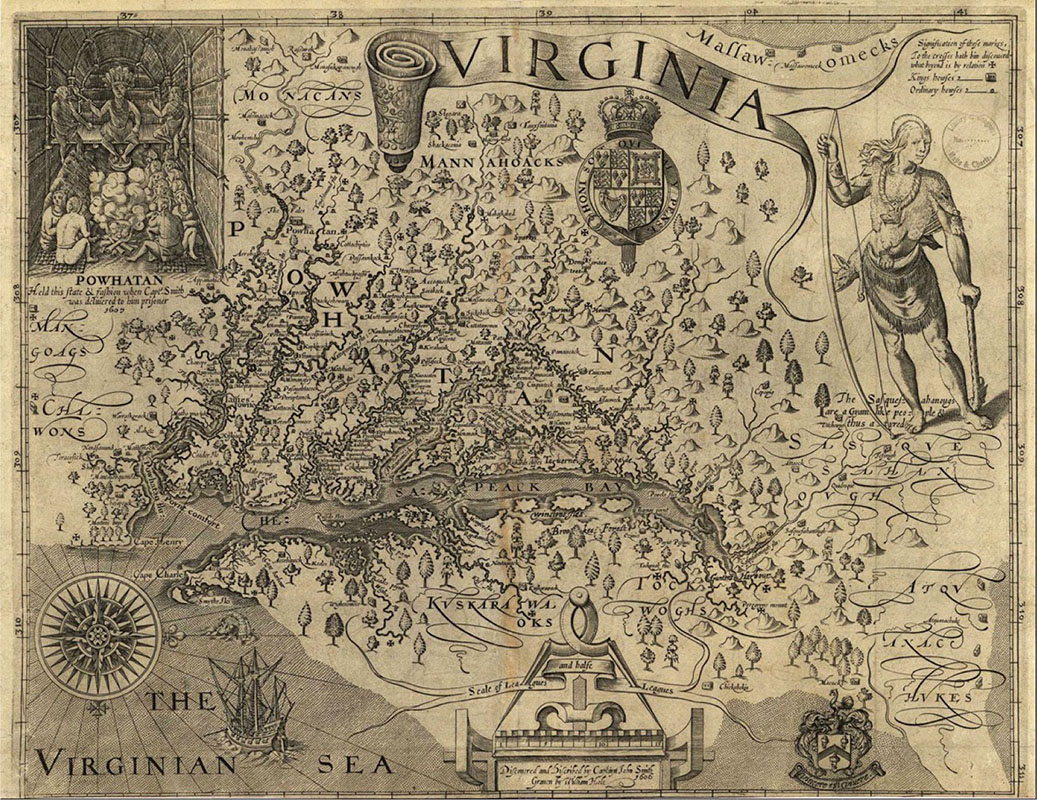Module 3: Chapter 3: Creating New Social Orders: Colonial Societies, 1500–1700
Section outline
-
 Image from Chapter 3 of U.S. History (opens in new window) from OpenStax, licensed under Creative Commons Attribution License v4.0 with the image information: John Smith’s famous map of Virginia (1622) illustrates many geopolitical features of early colonization. In the upper left, Powhatan, who governed a powerful local confederation of Algonquian communities, sits above other local leaders, denoting his authority. Another native figure, Susquehannock, who appears in the upper right, visually reinforces the message that the English did not control the land beyond a few outposts along the Chesapeake.
Image from Chapter 3 of U.S. History (opens in new window) from OpenStax, licensed under Creative Commons Attribution License v4.0 with the image information: John Smith’s famous map of Virginia (1622) illustrates many geopolitical features of early colonization. In the upper left, Powhatan, who governed a powerful local confederation of Algonquian communities, sits above other local leaders, denoting his authority. Another native figure, Susquehannock, who appears in the upper right, visually reinforces the message that the English did not control the land beyond a few outposts along the Chesapeake.Last week, you learned about early European exploration and colonization especially by the Spanish. This module will explore the expansion of Spanish colonial settlements throughout the Americas, Dutch and English colonial challenges to the Spanish in North America, England's first attempts at settlement in America including Jamestown, the impact of colonization on America. Students will get their first exposure to the earliest permanent English settlements, which eventually became the foundation of the 13 original British colonies and ultimately, the United States of America.
Upon completion of this module, you will be able to:
1. Demonstrate knowledge of the main Spanish American colonial settlements of the 1500s and 1600s. (CO 1 and 2)
2. Identify some of the key aspects of the Dutch and French colonies in North America. (CO 1 and 2)
3. Recall some of the most significant details about the first English settlements in America. (CO 1 and 2)
4. Recognize some of the most important effects of colonization such as the rise of slavery, changes to Indian life, and/or environmental changes.(CO 1 and 2)
5. (ASSIGNMENT ONLY): Discuss some of the problems facing the English as they tried to settle Jamestown based on the reading of a primary source. (CO 1, 2 and 3)To achieve these objectives:
- Read the Module 3 Introduction above
- Read and view the materials in the Chapter 3 Pressbooks book below.
- View the Chapter 3 PowerPoint below
- Complete Module 3 quizzes/assignments/discussion boards based on chapter reading, PowerPoint, and primary source
Module Pressbooks Resources and Activities
You will find the following resources and activities in this module at the Pressbooks website. Click on the links below to access or complete each item.
- Read the Module 3 Introduction above
Background Colour
Font Face
Font Kerning
Font Size
Image Visibility
Letter Spacing
Line Height
Link Highlight
Text Colour
